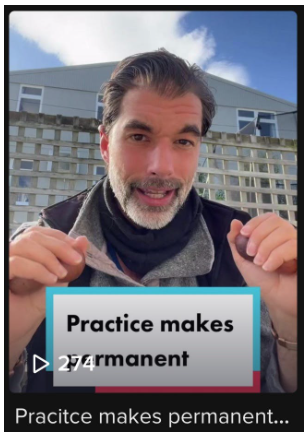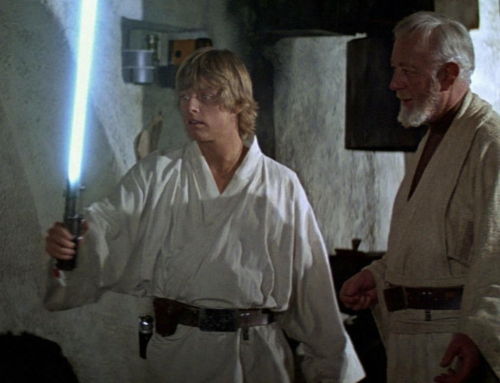I play guitar with my thumbs.
Not just my right thumb – it’s normal to use both the thumb and fingers when you are picking the strings – but my left thumb, too.
On the frets of a guitar, you use the fingers of your non-dominant hand to hold down some of the six strings, at precise positions, to play different notes. To play a chord, a guitarist presses a number of different strings on different frets with one hand, while strumming or picking with the other.
A G chord, in tablature notation, is 3 – 2 – 0 – 0 – 0 – 3. You hold down the third fret on the first string, the second fret on the second string, and leave the next three strings open. You also hold the third fret on the last string, to play the highest note (even though it is the furthest from you, and lowest on the guitar).
My left thumb makes an appearance around the neck of my guitar, because I learned chords badly. When I was fourteen and teaching myself how to play, I had a friend who knew more chords than me, and he showed me how to make a C chord.
X – 3 – 2 – 0 – 1 – 0 was what he showed me, and I asked him, ‘What do you do with the top string?’
‘Don’t play that string,’ he said. ‘It’s not part of the chord.’
As I practiced this new chord, I adjusted my fingers in dozens of micro-movements, to avoid playing the top string. X – 3 – 2 – 0 – 1 – 0 could be strummed if I held my right thumb on the top string, as I flicked with my left fingers. But when I tried changing from G chord to C chord and back, I kept forgetting to change the hand positions of both my right and my left hands.
So I gave myself a shortcut, and it’s a bad habit that I carry to this day.
Whenever I make a C chord with my left hand, my left thumb snakes around the backside of my guitar, and nestles right against the big fat E string, to prevent it from vibrating. This way I can hit all the strings, and the top string is muted.
My C chords sound precise, but my left hand position does not allow me to switch quickly into a bar chord. Bar chords are tough, if you have short fingers like mine. You need all four of your fingers, and your index finger has to lay across the entire neck of the guitar, holding down all of the strings. This allows your three weaker fingers to hold down various other notes on the fretboard.
Holding this difficult hand position is easiest if your left thumb is pressed firmly into the back of the neck of the guitar. This gives your weak fingers something strong to push off of, so you don’t have to exert pressure with those small fingers. You can hold a position with your fingers, and apply pressure with your thumb.
The neat thing about bar chords is that you can move the same hand position around the guitar. You can make any chord you want, with your fingers in the same position, if you put it in the right place. I know a few songs with bar chords, but I’m not that good at them, because I can only play songs that stay in bar chords the whole time. Any chord that transitions between a bar chord and the C chord is nearly impossible for me, because I practiced poorly.
Practice doesn’t make perfect; practice makes permanent.
Because I learned badly, my habits are deeply ingrained. I practiced playing C chord the wrong way for years. I was convinced that this wasn’t wrong, it was just my unique style of doing things my own way.
Playing C by muting the E chord with my thumb became a badge of my character, cocky teenager that I was. I liked the way it sounded, and I liked it that other guitarists would come up and challenge me on my hand position (because they could see from across the room that I was doing it wrong, with my thumb sticking up in the air). This uniqueness cost me a lot of basic function as a guitarist.
One day I decided to really work on my bar chords, and I learned the song Hook by Blues Traveler. It’s a dreamy progression, moving your cramped hand around the guitar, strumming serene secrets. After practicing this song and working my muscles so they could handle holding a bar, I tried learning another song with a bar chord, that happened to have a C chord after it. This was when I discovered what I had done to myself.
I was unable to play without re-learning from the beginning. My hands had learned the wrong way to do it, and it was even more difficult to change this habit than it was to learn it wrong in the first place.
Here’s a recent example of when I caught my poor practice early on TikTok:
Practicing poorly prevents perfection.
What you repeat is easily repeated. Unlearning a habit is difficult, because you’ve developed neural pathways that help you do something without thinking about it.
Your subconscious mind steps in as you learn something repetitively, and shoulders the burden of maintaining that task. The first time you drive a car, it takes all of your focus and attention. By the 50th or 500th time you drive, you need less of your conscious attention. After you have driven 5000 times, your subconscious mind does most of the driving, leaving your conscious mind free to focus on something else.
If you learn to drive on the right side of the road, there are thousands of micro movements that have to be unlearnt when you drive on the left. When I moved to New Zealand, I had been driving on the right side of the road for decades. I had to go back and relearn a lot of the basics, just so I could retrain my brain to do things differently.
Here is a video of the first time I drove on the left in New Zealand:
The weirdest thing about driving on the left is when you see another car in the distance on a curved road. The other car looks like it’s on the correct side of the road to your old eyes, but as it gets closer it has to cross your path to get onto the side that is actually correct. For the first few months, I had to continually calm my wired brain down as I caught my breath, out of fear I was about to collide into oncoming traffic.
How you practice becomes a part of you.
Get it right the first time, or you’ll have to start all over again forever. If you’ve already practiced so poorly that you cannot go back to the beginning, then think of the graceful gondola, and how it has adapted to tendency.
In the Italian city of Venice, there are few roads, and many canals. To travel across the city, a gondolier will ferry you in a long, curved boat called a gondola. These boats are slim and curved, to accommodate the tendency of gondoliers to push with their poles from one side of the boat.
|
|
If you’ve ever been in a canoe or kayak, you may have noticed that using your paddle on one side will send you around in circles. To go in a straight line is impossible – each paddle to one side turns you to the other side. But if you alternate left and right, you can weave left and right as you go forward, and average a straight line.
Gondolas do not have the luxury of switching sides. The long poles reach deep into the ancient muck at the bottom of the Venice canals, and moving the pole to the other side of the boat would be laborious. As they sing Italian librettos, gondoliers push their poles off one side of the boat, only.
The boat is constructed with a curve in the keel, to accommodate this tendency.
If you were to switch sides on a gondola, pushing your pole on one side and then another, it would not go in a straight line. The construction of the boat itself is made to accommodate the tendency of gondoliers to use their pole on one side. If you have a bad habit that is deeply ingrained, is there something you can change to accommodate this tendency?
The master learns the basics slowly.
It is foolish to learn a habit that has to be unlearnt. If you practice something perfectly, you hardware the neural pathways to repeat it. If you practice badly with poor form, over time you habituate yourself to doing it wrong. Bad practice prevents you from doing it right.
There are two variables in the adoption of any habit: frequency and time. You can practice a habit once, and never do it again; or you could do it 100 times, over months, or weeks, or days. Which would give you the best opportunity to adopt a new habit?
When you first begin a new habit, it has to be done consciously. You need to think about it every time. But after a few repetitions, you can do it without consciously putting your mind to it. The subconscious habit only relies on the cue, and once the cue is observed, like Pavlov’s dog, the routine begins automatically. It just takes frequency over time, but it may take longer than you think.
When Maxwell Malz was a plastic surgeon in the 1950s, he noticed that it took a few weeks for his patients to get used to their new face. He found this curious, because it was the same length of time that people who had an amputation experienced a ‘phantom limb’ – about 21 days.
He shared this observation in his book Psycho-Cybernetics, and it was picked up by motivational speakers like Tony Robbins and Zig Ziglar as the ideal length of time it took to form a habit: 21 days. You may have heard this in the decades since, many times. It’s become a foundational tenet of personal development lore, that 21 days was all the time it took to create a habit.
But then Phillippa Lally published a study in the European Journal of Social Psychology, where she asked a few dozen people to try a new habit for 12 weeks. The habits were eating, drinking, or activity-based, and all of the habits happened after a meal. Participants charted how often they successfully practiced the habit, and the study found that “the time it took participants to reach 95% of their asymptote of automaticity ranged from 18 to 254 days.”
If you think of some of your current habits, you may notice that they took longer than three weeks to become a subconscious, ingrained habit. This is in line with the scientific literature – practice makes permanent, but not right away.






Leave A Comment